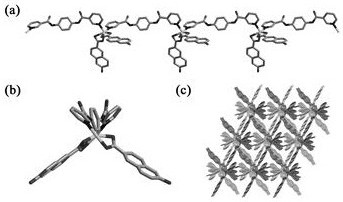Zinc complex, synthesis thereof and method for recognizing Fe < 3 + > ions in fluorescence
A zinc complex and fluorescence recognition technology, which is applied in the direction of fluorescence/phosphorescence, zinc organic compounds, chemical instruments and methods, etc., can solve the problems of changing absolute luminous intensity, inaccurate luminescent signal, and distortion of detection results, etc., achieving low cost, The effect of high sensitivity and short response time
- Summary
- Abstract
- Description
- Claims
- Application Information
AI Technical Summary
Problems solved by technology
Method used
Image
Examples
Embodiment Construction
[0032] The following will clearly and completely describe the technical solutions in the embodiments of the present invention with reference to the accompanying drawings in the embodiments of the present invention. Obviously, the described embodiments are only some, not all, embodiments of the present invention.
[0033] refer to Figure 1-6 , a zinc complex and its synthesis and recognition of Fe in fluorescence 3+ The method of ion, comprises the steps:
[0034] S1 complex [Zn(3-bpam)(6-HNA) 2 ]Synthesis;
[0035] S11 will 0.0594g Zn(NO 3 ) 2 ·6H 2 O, 0.032g N, N'-bis(3-pyridinecarboxamide) (3-bpam), 0.037g 6-hydroxyl-2-naphthoic acid (6-HNA) were added in a 25mL beaker;
[0036] S12 Subsequently, 3 mL of deionized water and 3 mL of absolute ethanol were added thereto;
[0037] S13 stirring the obtained mixed solution at room temperature for 30 min;
[0038] S14 After transferring the mixed solution to a polytetrafluoroethylene-lined autoclave with a volume of 25 mL, p...
PUM
 Login to View More
Login to View More Abstract
Description
Claims
Application Information
 Login to View More
Login to View More - R&D
- Intellectual Property
- Life Sciences
- Materials
- Tech Scout
- Unparalleled Data Quality
- Higher Quality Content
- 60% Fewer Hallucinations
Browse by: Latest US Patents, China's latest patents, Technical Efficacy Thesaurus, Application Domain, Technology Topic, Popular Technical Reports.
© 2025 PatSnap. All rights reserved.Legal|Privacy policy|Modern Slavery Act Transparency Statement|Sitemap|About US| Contact US: help@patsnap.com



